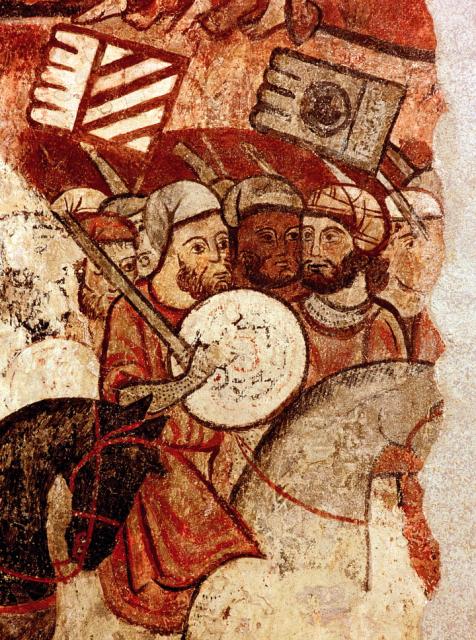It is possible that the use of this kind of converted wagon first started in Poland and then spread to Bohemia where they were used to great effect in the Hussite Wars. They were then adopted by Hungary and in Germany, with similar types being used in Russia.
Below are some of the wagons I have. The crew is a real mix. There are figures from Donnington, Khurasan, Minifigs, Irregular, QR, Vexillia and Mirliton. The Donnington peasants are particularly useful, with very Bohemian style clothing (15th century - not 1950s Greenwich Village).
 |
| Irregular |
These are the two styles of wagon from Irregular Miniatures. The wagon itself is the same in each case - the separately cast side planking is the difference. I think the style of planking is randomly provided.
They also do a wagon of the same style which comes with a small artillery piece.
 |
| Irregular |
I have more Irregular wagons than any other, with enough to have some shooting to the left and some to the right.
Note the stone thrower - the wagons often had containers filled with stones for bombarding the enemy. Some other wagons have the stone throwing Swiss figures from Khurasan in them.
 |
| Alternative Armies |
This wagon is from Alternative Armies (until recently sold as 15mm.co.uk and originally by Tabletop Games).
The wagons require more construction than the Irregular pieces. The sides of the actual wagon are separate but come with different options including the open ramp for one side. They come with horses but I decided to do them in a static pose.
It took a while to work out how to get everything together but once it was cleaned up of flash etc. they went together quite smoothly.
 |
| Alternative Armies (rear view) |
This one has an artillery piece from Minifigs deployed alongside. The gunner is from QR, the shield bearer from Irregular.
It also comes with a small section to go under the wagon - I haven't put these in as they are difficult to see but perhaps I will get round to it one day.
 |
| Minifigs |
The Minifigs wagon has a one piece body with separate side hoarding. It is also provided with the under cart protection. It comes with two pairs of horse but I used Irregular horses for all the wagons.
The body of the examples I had from Minifigs needed a bit of tidying up including some filling but nothing too onerous
I also have some by QR miniatures. These are much smaller though still pretty nice. Each pack has two wagons - one is dug in with its wheels partially buried.
Museum have fairly recently produced a range of war wagons. These look nice, and follow several modern reconstruction. However, I'm not convinced that the modern artists have interpreted the sources well - hinged side panels have become propped up roofs.
There are some very pretty war wagons on various websites, whereas I have gone for the plain wood look. This is based on contemporary pictures such as the Schlact im Walde* and the picture at the head of this blog.
What I will need to do is to add flags to some of the wagons. There are specific designs for different parts of the Hussite army. Since I have rather a lot of wagons, I may add some Hungarian heraldry to a few, as in Győző Somogyi's book on the army of Matthias Corvinus.
Wagner, Drobna and Durdik's book on Medieval Costume, Armour and Weapons has a particular emphasis on the Bohemians and shows several good pictures of wagons. Worth looking at, despite its age.
Much newer are the pair of books on die Heere den Hussiten. The plates aren't as interesting as the same company's book on the Teutonic Knights, so if you are not a German reader then I wouldn't recommend them.
*A wonderful source for the late 15th/early 16th century in Germany. One thing it shows is the wagons moving around the field, but how typical this was and how much is artistic licence is of course debatable. This and two subsequent posts give more details of the battle. A short account by von Berlichingen is here - this confirms that the wagons were attacked while still trying to form a wagenburg.


_10.jpg)


















